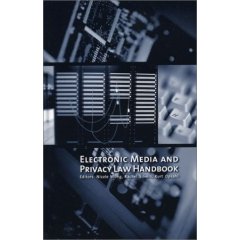Electronic Media and Privacy Law Handbook
The Handbook was co-edited by Nicole Wong, Rachel Silvers and Kurt Opsahl, who were attorneys with Perkins Coie LLP at the time.
2003 Print Edition Acknowledgements
"The editors are grateful to the many talented people who have worked on this project over the years, and in particular wish to acknowledge the hard work and dedication of Abigail Phillips and Suchon Tuly, without whom this Handbook could not have been produced. In addition, the editors wish to thank Oscar Cisneros, Mukya Porter and Malcolm Yeung for their help in bringing the material up to date.
Special thanks are owed to Debra Hemrich for her assistance in formatting this work and to the talented people in the Perkins Coie Client Relations department for their assistance in bringing this book to print."
Preface to 2003 Print Edition
The end of the twentieth century was dominated by the extraordinary growth of the Internet as a communications medium and commercial engine. An intrinsically libertarian and democratic technology, the Internet enjoys a rare place in history as a force that revolutionized our economy, our societal structure and the express and unwritten rules that underpin them. It reduces the barriers to entry to the global marketplace of ideas, allowing small startup companies a chance to compete with established businesses for customers around the world, and the high school newspaper the chance to scoop the network news. As Justice Stevens noted in the Supreme Court's first opinion on the nature of the Internet in Reno v. ACLU:
This dynamic, multifaceted category of communication includes not only traditional print and news services, but also audio, video, and still images, as well as interactive, real time dialogue. Through the use of chat rooms, any person with a phone line can become a town crier with a voice that resonates farther than it could from any soapbox. Through the use of Web pages, mail exploders, and newsgroups, the same individual can become a pamphleteer. As the District Court found, 'the content on the Internet is as diverse as human thought.'
At the same time, the unprecedented power offered by electronic media also threatens the previous paradigm of individual privacy, allowing strangers to bombard our electronic mailboxes with spam or track our Internet surfing and purchasing habits. New technologies pose challenges to the purveyors of copyrighted content, as the costs of distribution decline and the ease of unauthorized copying forces new business models. At the beginning of a new millennium, it is clear that electronic media and privacy issues will continue to be of critical concern to companies doing business on the Internet, to individual consumers, to governmental agencies, and to our society as a whole. We originally created this Handbook to keep note of the handful of cases that helped us navigate the uncharted waters of "cyberspace." Since its beginnings in 1996, the Handbook's summary of cases has swelled to more than 300, supplemented by myriad state and federal statutes and industry initiatives. It is an invaluable resource for legal counsel and global business leaders, as well as to anyone who wishes to litigate, research or study the issues that arise when law and technology intersect. Our discussion of law is divided into eight substantive areas that provide the greatest impact on companies with an Internet presence: Defamation, Content and Speech Regulation, Copyright, Trademark, Confidential Information, Electronic Contracts, Privacy and Data Collection, and Marketing Issues. We have made significant efforts to provide a lucid and succinct guide to the most important cases and statutes related to electronic media and privacy. This Handbook, however, is not intended to be a comprehensive update on the law. Instead, it is an easy-to-use reference for the legal practitioner, scholar or observer. We welcome your comments or questions for future editions of the Handbook,
Nicole Wong, Rachel Silvers and Kurt OpsahlSan Francisco, November 2003.
